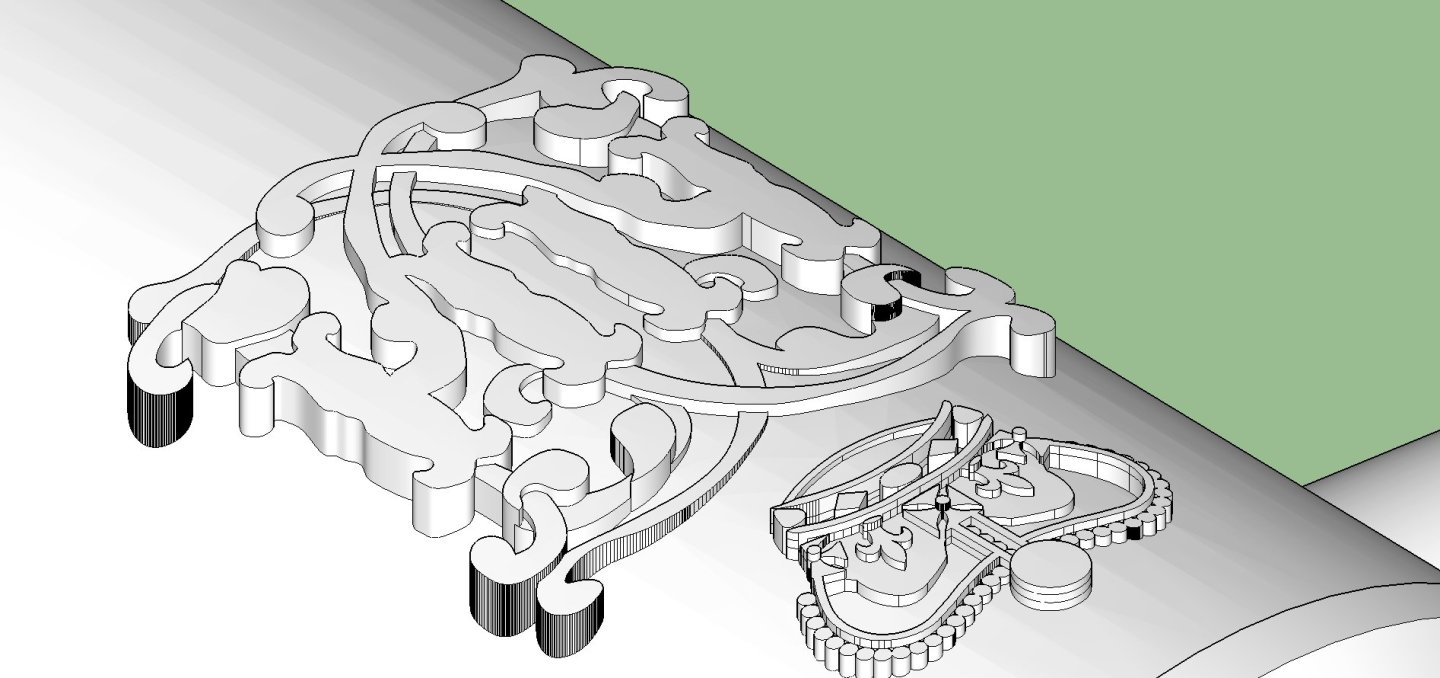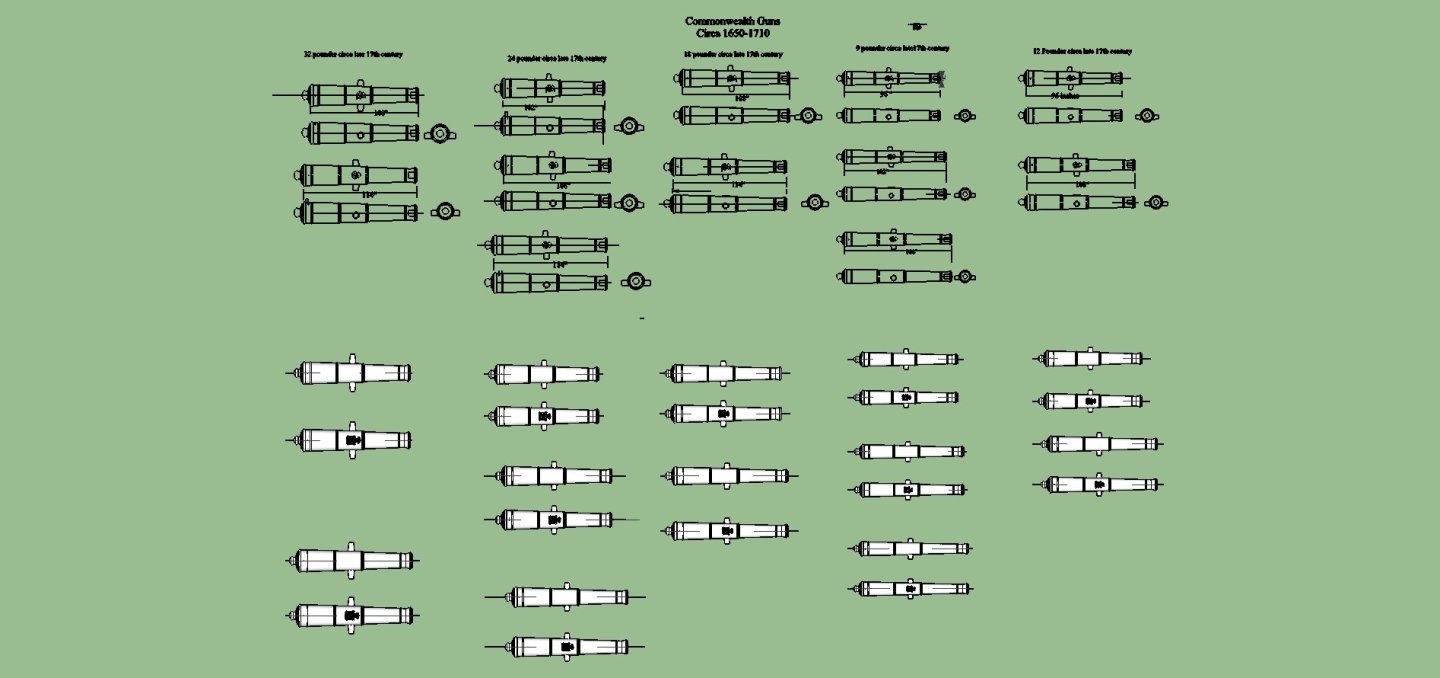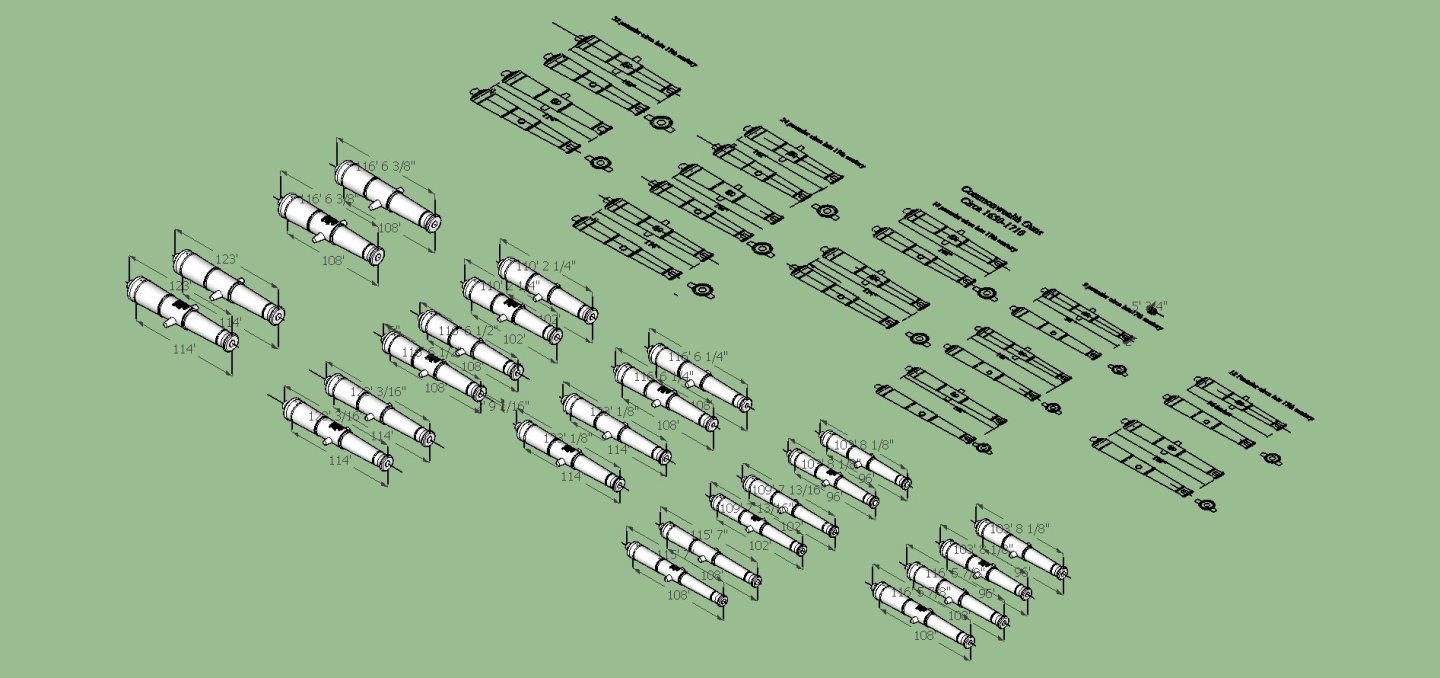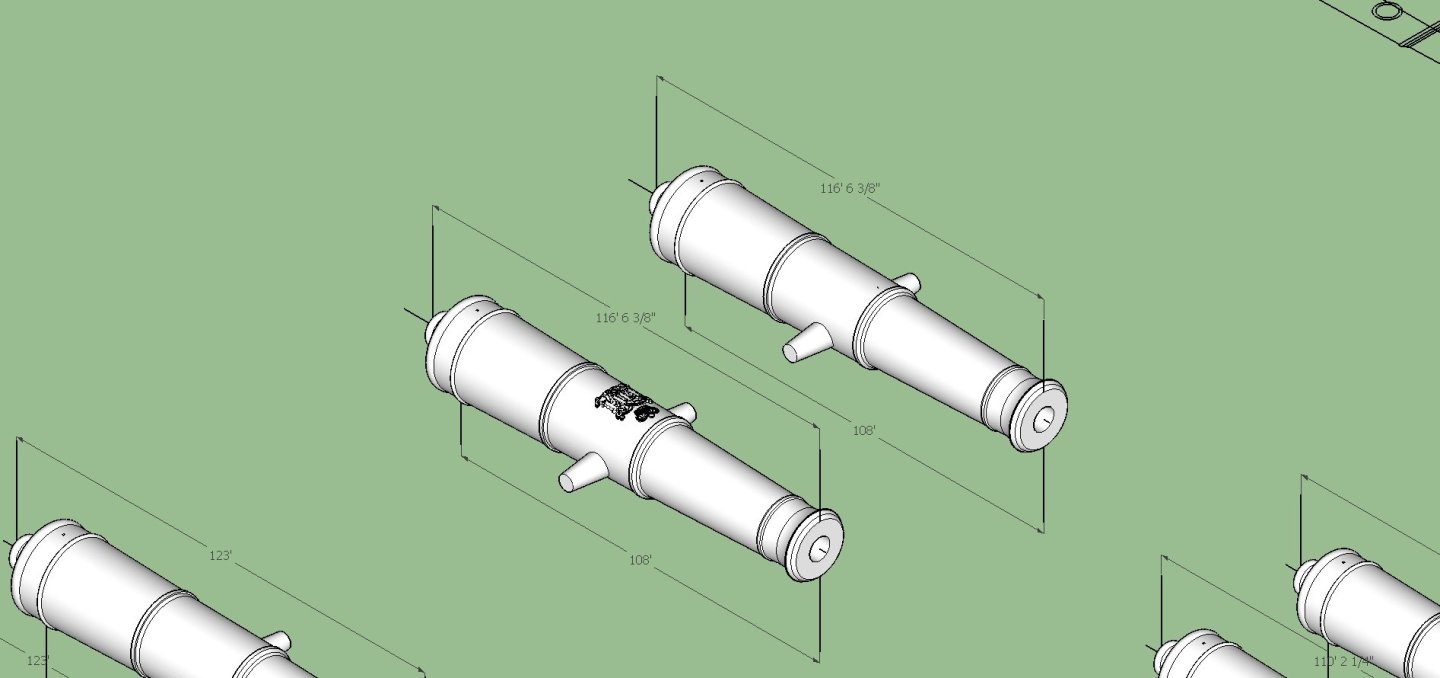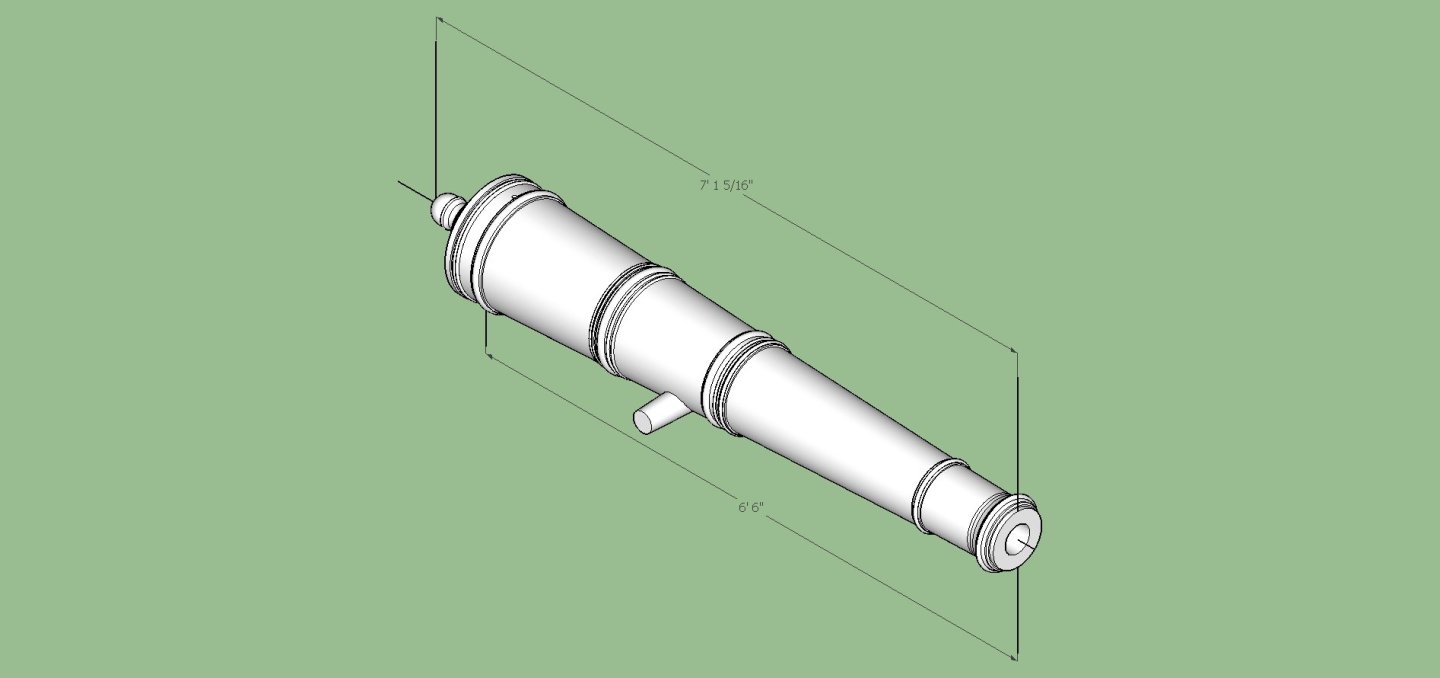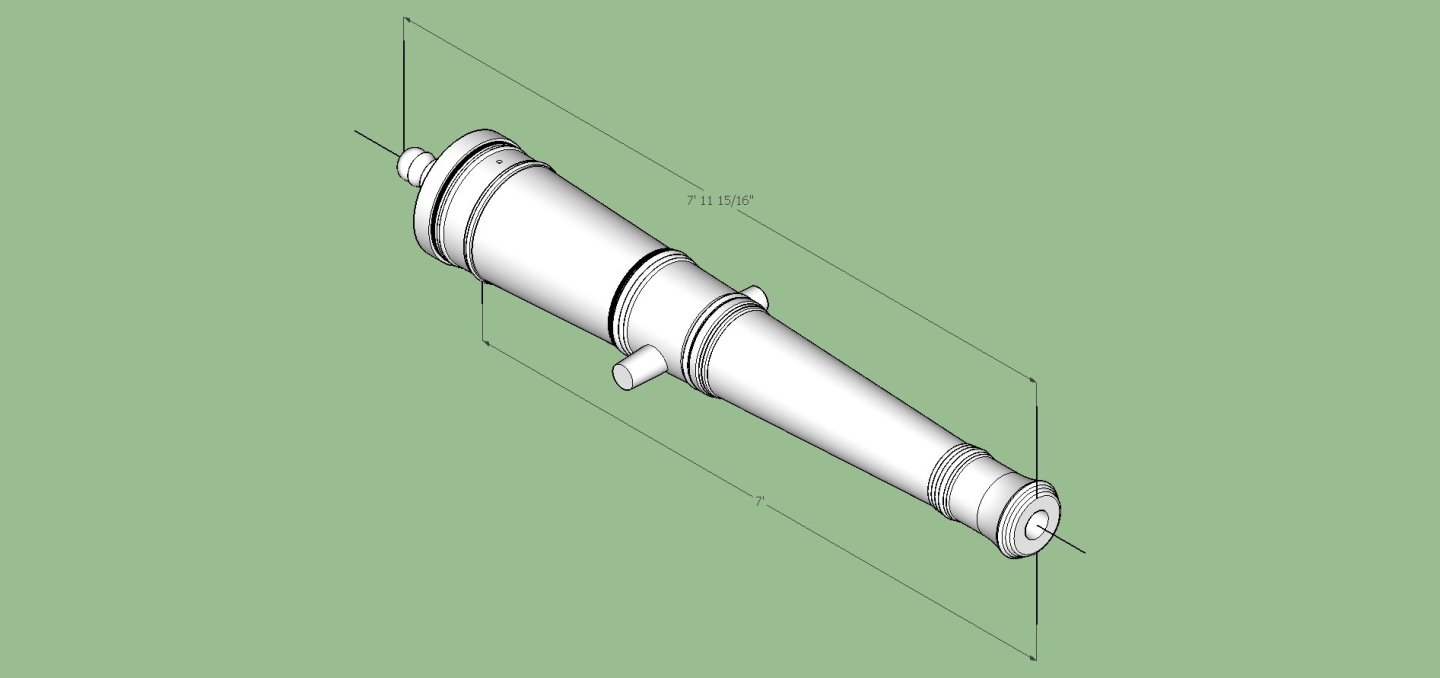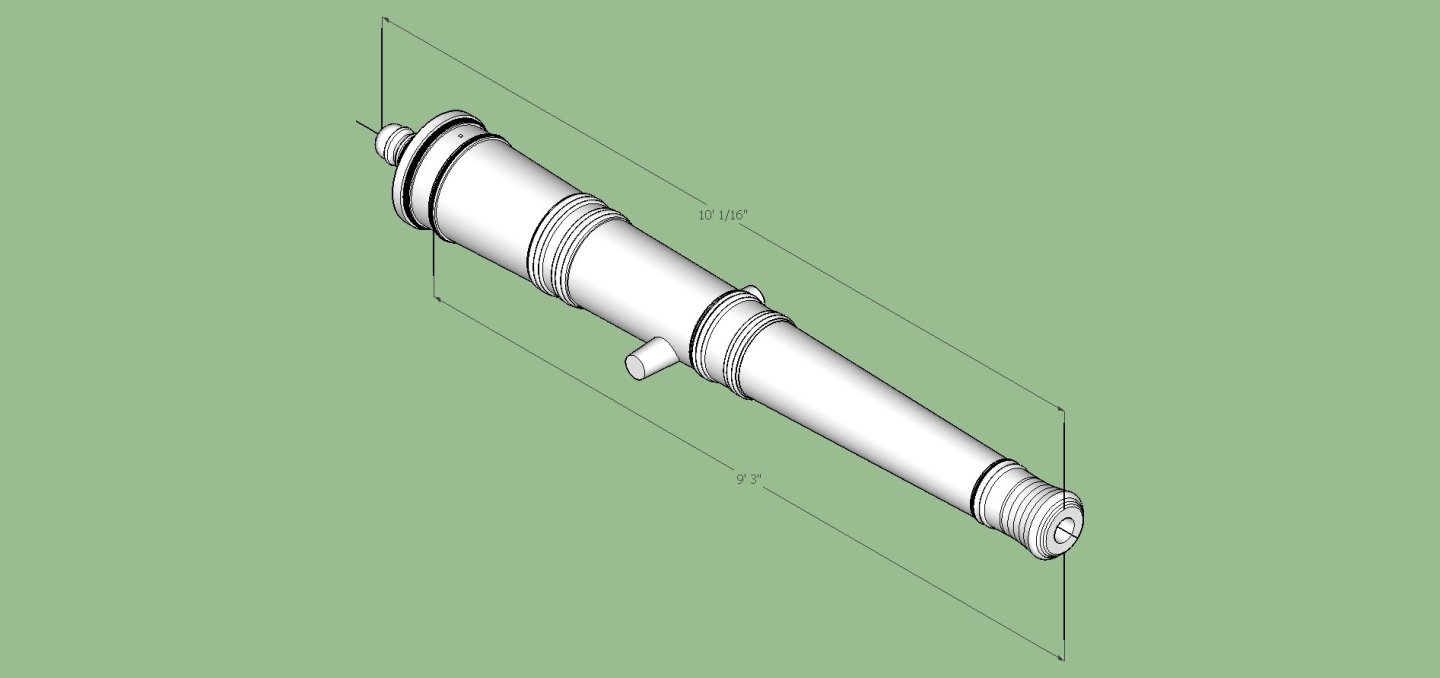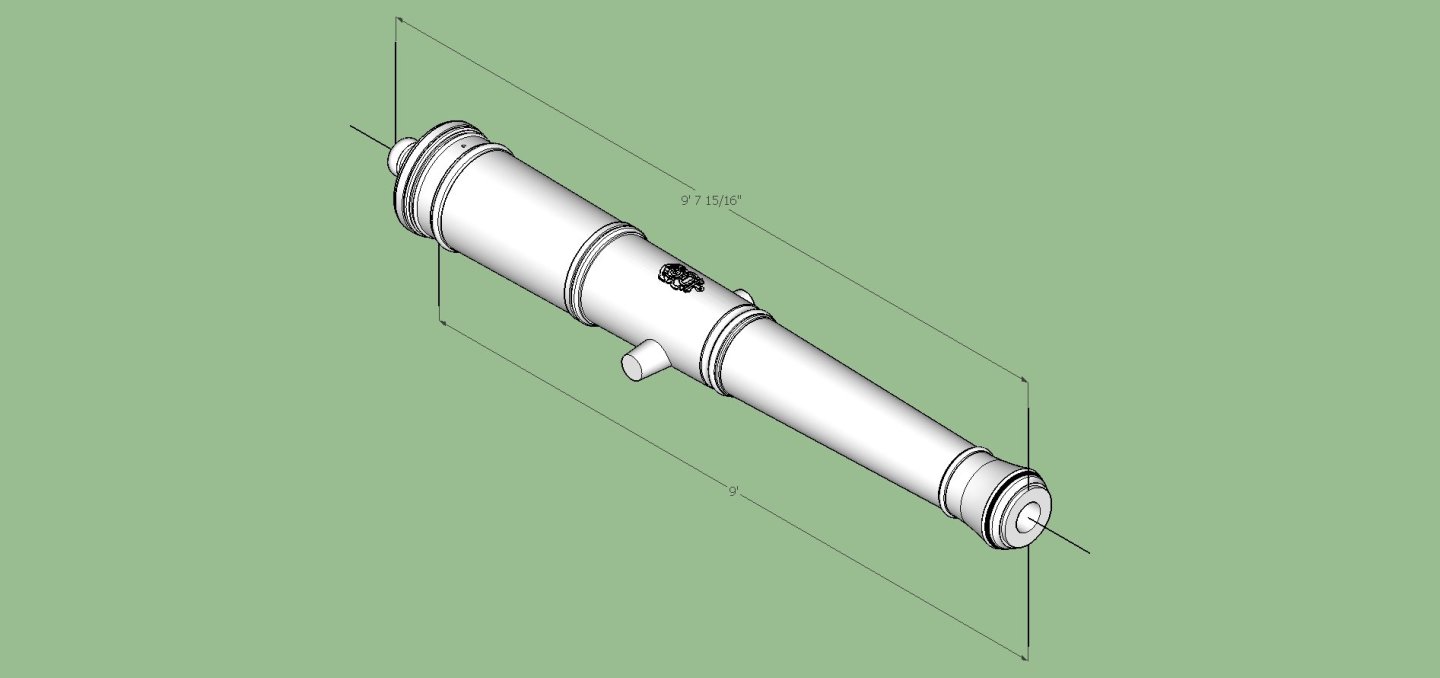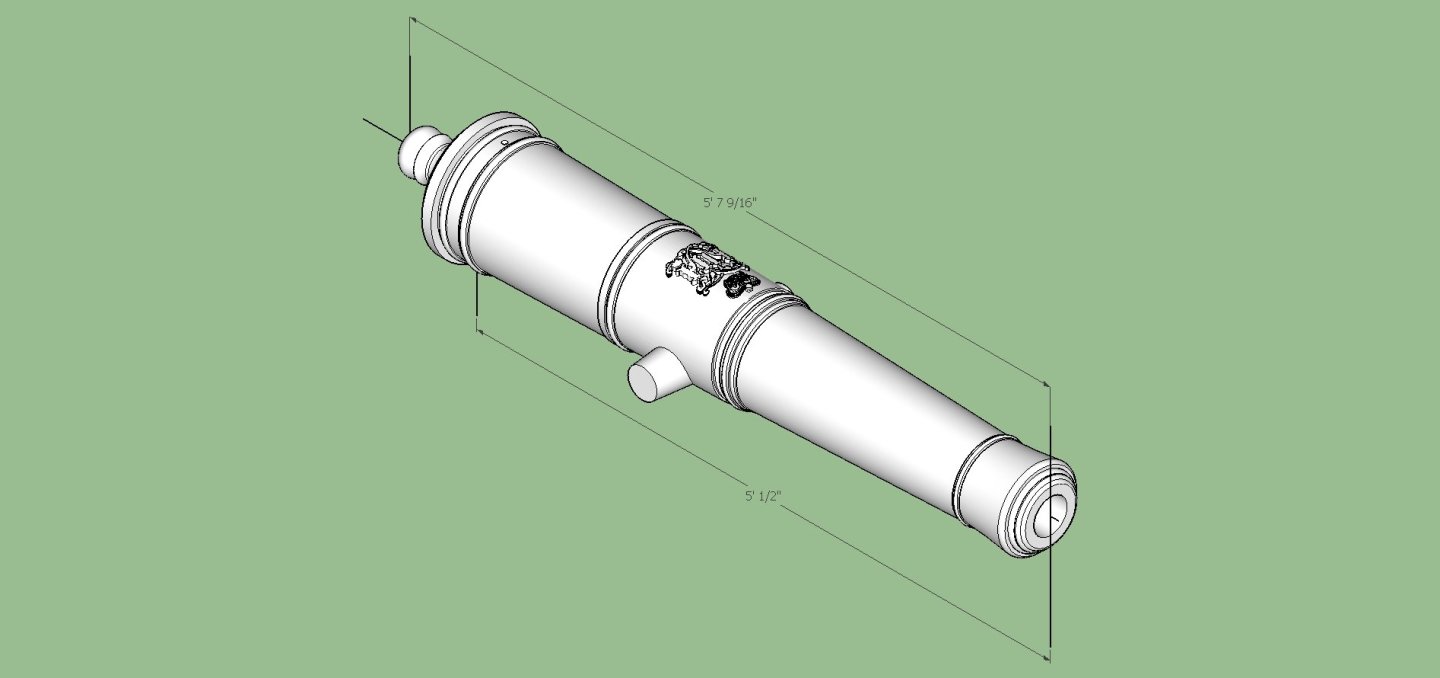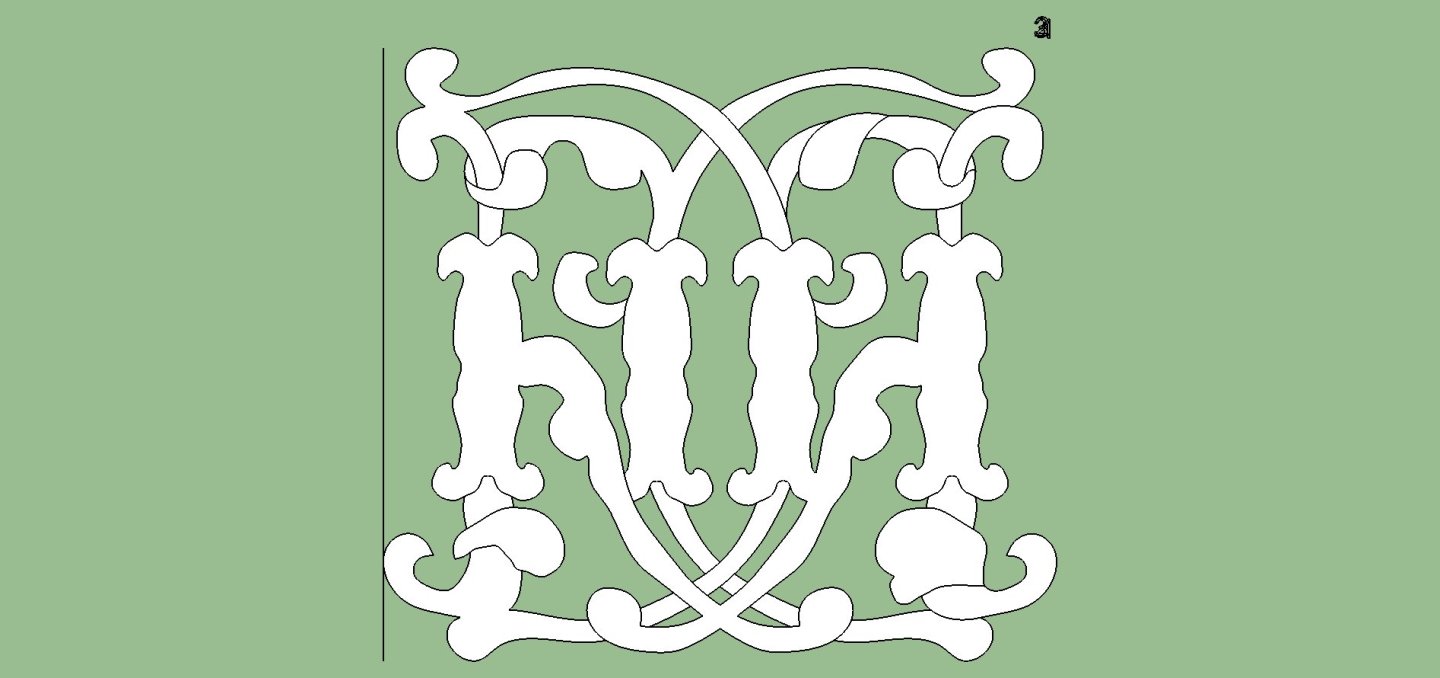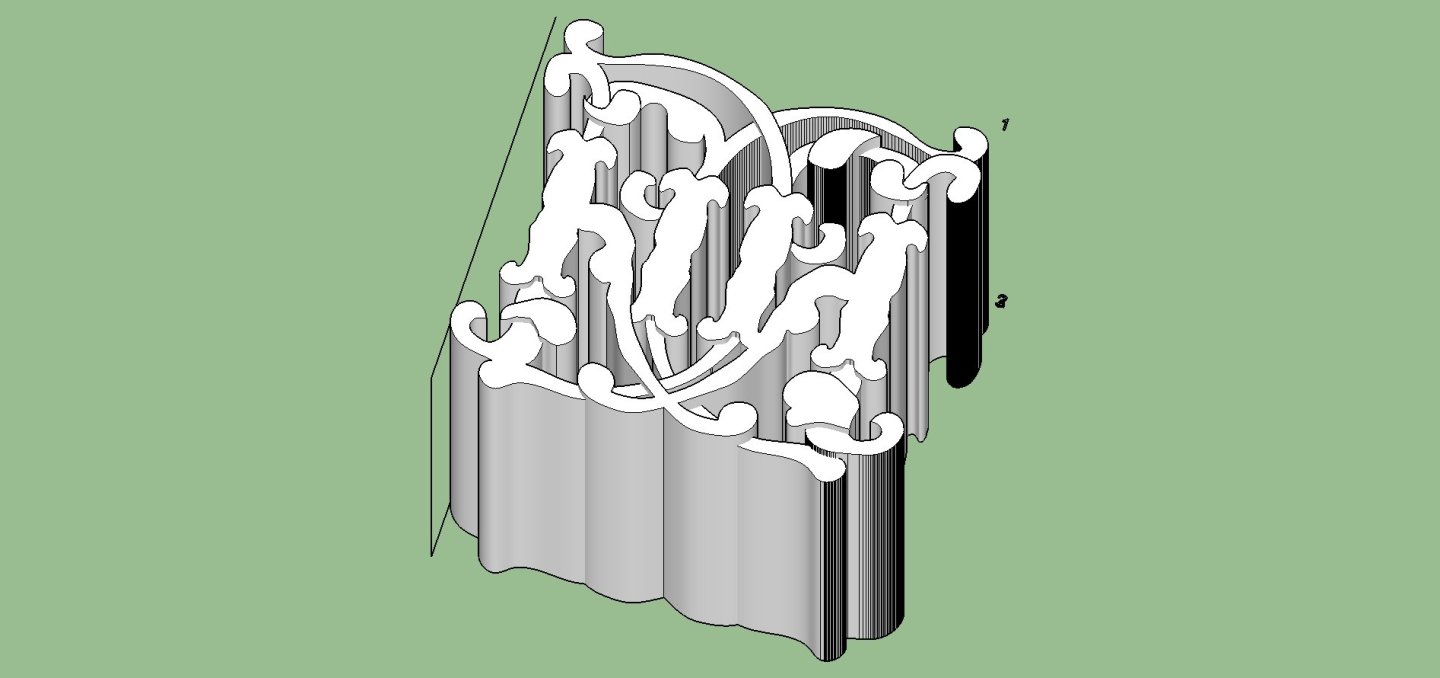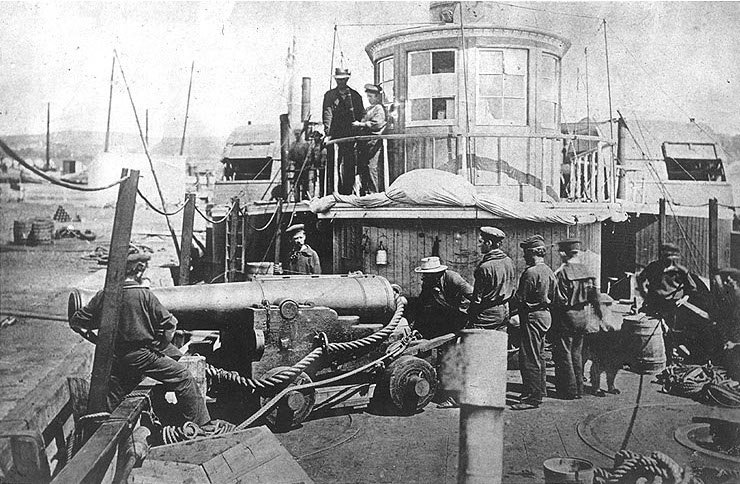-
Posts
2,926 -
Joined
-
Last visited
Content Type
Profiles
Forums
Gallery
Events
Everything posted by thibaultron
-

3D Printing Cannons in Resin
thibaultron replied to thibaultron's topic in 3D-Printing and Laser-Cutting.
I finished the drawings for the Commonwealth Pattern cannons from 1650 to the end of Charles II's reign. The original pattern was developed during the Commonwealth control 1640 to 49, and originally featured their cypher. When Charles came to power those cyphers were removed from the existing cannons, leaving cannons with plain barrels. These drawings feature the plain barrels and those with Charles' cyphers. I still need to go through and create the STL files, and the graphics for each cannon, as well as updating the spreadsheet to include them. So it will be a couple of weeks before I publish them. I hope to add these to the NRG Resource page. Overhead and perspective views with the original 2D drawing at the top. The 2D drawing mistakenly shows the Tutor Rose as the correct cypher. A closeup of one of the larger caliber guns showing both types of barrels. Note: that the drawing shows them 12X size this is how I typically scale the drawings to be able to get the fine details, as SketchUp is designed for architecture and has a 1/32" minimum drawing unit (at least my 2017 version). For these drawings I had to go with 144X due to the small "pearls" in the crown. When I create and verify the STL files, I rescale to 1:1 in the verification program. -

M3A1 Scout Car by brunnels - Tamiya - 1/35 - PLASTIC
thibaultron replied to brunnels's topic in Non-ship/categorised builds
I found the above on Ebay. Are these what what you are looking for? -

M3A1 Scout Car by brunnels - Tamiya - 1/35 - PLASTIC
thibaultron replied to brunnels's topic in Non-ship/categorised builds
https://www.ebay.com/itm/175335227343?_skw=M3A1+Scout+Car+6+hole+wheels&itmmeta=01K59FRXJS4THZ3CCT7MCVQK5F&hash=item28d2cb3fcf:g:pOwAAOSwWgtivEAR&itmprp=enc%3AAQAKAAAA4FkggFvd1GGDu0w3yXCmi1ejOSTayye1qs01G3rCbsUF0XjrGoaLJ3iikEKmN0yUGuL0amYfy6FLybKgPkhxTPYAF%2Bu8j%2BpTHEDFIBJmSL59nIHQdAq798i0B2sPIAy3mCZkQOwtj%2FyMej70wAdMcSLI4R2DYyDaAGPFICQR4jW1Q9sQeQxI0lFdjrj6l1PIpwGd9ujWOnaJ6PmPV4RGK1GrtIZjR6W13C92XFzQB4qG%2BMksHVmqEZ83mUiK%2FlgpA7HB3C9C91eK8nXSQImvfM8DbAKXIrKFyJYUksYV60pe|tkp%3ABk9SR-LZ46-qZg -
If you store your IPA and water(if used),in sealed clear or very translucent containers, you can set them in the sun between sessions and the sun light will cure the resin. After the resin cures it will fall to the bottom of the container, and can be filtered out. This allows the fluids to be reused many times, before they become to "dirty" to reuse.
-

3D Printing Cannons in Resin
thibaultron replied to thibaultron's topic in 3D-Printing and Laser-Cutting.
On a note about the above post. The Commonwealth Pattern cannons came in three major "favors". With the Commonwealth Cypher, a plain barrel (After King Charles reign started, the Commonwealth cypher were filed off any existing cannons), and with the Charles II cypher cast on. I have the defaced, plain, barrels drawn, already. I will not be doing the Commonwealth cypher for this set. The cyphers take a long time to get right, and I have many projects on my plate, so drawing a cypher that only spanned 10 years is more than I want to take on. The same applies for any cannons cast after Charles reign, if the cypher pattern was changed. -

3D Printing Cannons in Resin
thibaultron replied to thibaultron's topic in 3D-Printing and Laser-Cutting.
Finished the files for the cannons on HMS Tiger ca. 1650 to 1690. I'm not sure just when this set of cannons were carried. The cannons are from illustrations in the book "The Master Shipwright's Secrets". Three of the cannons in the pictures had no cypher, so that is how I drew them. These drawings were requested by a forum member. 6 Foot 6 Inch Saker 6 Pounder 6 Foot 6 Inch Saker 6 Pounder Full Size_2166_14mm.stl 7 foot Saker 6 Pounder 7 Foot Saker 6 Pounder_Full Size_2436_94mm.stl 9 Foot 3 Inch Saker 6 Pounder 9 Foot 3 Inch Saker 6 Pounder Full Size_3050_38mm.stl 9 Foot Demi-Culvern 12 Pounder This was shown with the Tudor Rose cypher. 9 Foot Demi_Culveren 12 Pounder Full Size_2945_34mm.stl Rupertino Saker Cutt 6 Pounder. This cannon is based on a cut down cannon. They shortened cannons from a previous design whose muzzles had cracked, for the original Cutt cannons, liked the performance, and cast new cannons to this length with a muzzle flair. This cannon has the King Charles II cypher. Rupertino_Saker_Cutt 6 Pounder Full Size_1716_09mm.stl Though I can't promise when, I have already drawn the Commonwealth Pattern cannon barrels, and will be posting them after I've added the Charles II cyphers. This cypher gave me a lot of trouble, and takes a while to "weld" to the 3D barrels. -

M3A1 Scout Car by brunnels - Tamiya - 1/35 - PLASTIC
thibaultron replied to brunnels's topic in Non-ship/categorised builds
What a wonderful reason to build a model! Thank you for sharing this! -

3D Printing Cannons in Resin
thibaultron replied to thibaultron's topic in 3D-Printing and Laser-Cutting.
Back to ship stuff. I finished the master drawing for the King Charles II cypher. This is the last piece for the HMS Tiger cannons I'm doing for a forum member. After I finish those I will complete the Charles II era Commonwealth cannons, to (hopefully) be added to the other cannon files in the Resources Section of the NRG site. The Commonwealth barrels are drawn, I need to add this cypher to the barrels. The depth of the Solid is so I can fit it in the 3D barrels. The 3 different levels of relief with be trimmed parallel to the barrel, and the part sticking inside removed. -
I asked Google if cocker spaniels were still having their tails docked? It replied that most were born with the tails docked! AI can not be trusted. By the way other sites said that yes they were for breed show standards. I thought we were over such things! At least the cat community has mostly stopped the declawing of cats.
-

The NRG office is back open
thibaultron replied to ferretmary1's topic in NAUTICAL RESEARCH GUILD - News & Information
Try Arthritis Strength 8 Hour Tylenol. That's what I took, and still do, after my replacement. -
Nice, though now I'm going to have to look up "Bacon Candy"!
-

A flag from Trafalgar flown by HMS Spartiate
thibaultron replied to druxey's topic in Nautical/Naval History
Thanks for the link! -
Not assuming the same density. I asked how big a planet 1.3 times the mass of Earth would be. (Mars and the assumed similarly size impacting proto-planet (named Thea) being about the same size.) So the starting value would be 1 Earth mass, not .9. And then it went off into strange assumptions and calculations.
-
If using CATGPT, just be careful to verify the answers! I asked it a simple question about what size a planet with 1.3 Earth masses would be, and it started with the Earth being .9 Earth masses, and went into LA LA land after that! (Yes, I have weird questions in my head! I was watching a documentary on the formation of the moon. Mars size proto-planet sideswipes Earth sized proto-planet and leaves our Earth, the Moon, and the leftover stuff escapes orbit).
-

3D Naval Guns 1850s ~ 1870s
thibaultron replied to JerryTodd's topic in CAD and 3D Modelling/Drafting Plans with Software
This is a picture of the USS Thomas Freeborn labeled as taken in 1861. I think this shows a gray, or faded black carriage. as the barrel is also gray. -

Hobby Laser Machine
thibaultron replied to kgstakes's topic in Modeling tools and Workshop Equipment
For CNC machining , as far as software, you will need at least windows 10, for compatibility with the other software. UGS software (free) is used to drive the CNC router directly from your computer, with newer CNC machines, via an USB cable. Some of the newest machine can use a thumb drive directly, to cut the file. To create the cutting files you need a "Creator" program to generate the cut files. The general ones are Easel (a very basic program, with limited 3D object usefulness). It requires an on going subscription. Carbide Create, better but not full 3D object machining and limited 3D model creation) also a subscription based program, with a high monthly fee. VCarve, Desktop ~$350 to purchase, no monthly subscription. For modeling you will still need to use some type of 3D CAD program to create the original scale model. The typical two used are both subscription based SketchUp and Fusion 360. I have not tried it but Blender is supposed to also be able to create 3D files that you can use to send the the CNC programs previously mentioned, and it is free! Others will have to chime in on the Blender option. -

The Mossy Shipyard by Bryan Woods - 1:1
thibaultron replied to Bryan Woods's topic in Non-ship/categorised builds
Would putting screens in the windows help reduce the bird impacts? Any opinions? -

Hobby Laser Machine
thibaultron replied to kgstakes's topic in Modeling tools and Workshop Equipment
For really small detailing, you might want to check out the 3030-PROVer MAX CNC Router Machine with Linear Guide & Ball Screw Motion, Achieve ±0.05mm Accuracy for High Precision Metal Aluminum Copper Acrylic Engraving, Supports 4th Axis Rotary Kit It has ballscrews for the axis feedscrews. The stated accuracy is + .05mm or 0.002 inches.
About us
Modelshipworld - Advancing Ship Modeling through Research
SSL Secured
Your security is important for us so this Website is SSL-Secured
NRG Mailing Address
Nautical Research Guild
237 South Lincoln Street
Westmont IL, 60559-1917
Model Ship World ® and the MSW logo are Registered Trademarks, and belong to the Nautical Research Guild (United States Patent and Trademark Office: No. 6,929,264 & No. 6,929,274, registered Dec. 20, 2022)
Helpful Links
About the NRG
If you enjoy building ship models that are historically accurate as well as beautiful, then The Nautical Research Guild (NRG) is just right for you.
The Guild is a non-profit educational organization whose mission is to “Advance Ship Modeling Through Research”. We provide support to our members in their efforts to raise the quality of their model ships.
The Nautical Research Guild has published our world-renowned quarterly magazine, The Nautical Research Journal, since 1955. The pages of the Journal are full of articles by accomplished ship modelers who show you how they create those exquisite details on their models, and by maritime historians who show you the correct details to build. The Journal is available in both print and digital editions. Go to the NRG web site (www.thenrg.org) to download a complimentary digital copy of the Journal. The NRG also publishes plan sets, books and compilations of back issues of the Journal and the former Ships in Scale and Model Ship Builder magazines.


